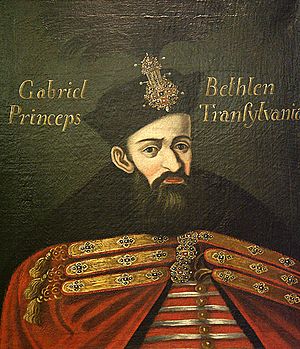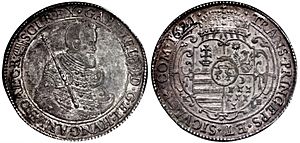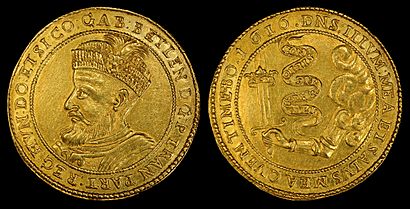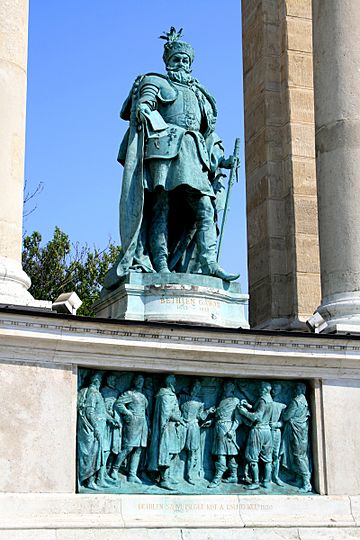Gabriel Bethlen facts for kids
Quick facts for kids Gabriel Bethlen |
|||||
|---|---|---|---|---|---|
 |
|||||
| King of Hungary | |||||
| Reign | 25 August 1620 – 31 December 1621 | ||||
| Predecessor | Matthias II | ||||
| Successor | Ferdinand II | ||||
| Prince of Transylvania | |||||
| Reign | October 1613 – 15 November 1629 | ||||
| Predecessor | Gabriel Báthory | ||||
| Successor | Catherine | ||||
| Duke of Opole | |||||
| Reign | 1622 – 1625 | ||||
| Predecessor | Sigismund Báthory | ||||
| Successor | Władysław Vasa | ||||
| Born | 15 November 1580 Marosillye, Principality of Transylvania (now Ilia, Romania) |
||||
| Died | 15 November 1629 (aged 49) Gyulafehérvár, Principality of Transylvania (now Alba Iulia, Romania) |
||||
| Spouse | Catherine of Brandenburg | ||||
|
|||||
| Family | Bethlen | ||||
| Religion | Calvinist | ||||
Gabriel Bethlen (born November 15, 1580 – died November 15, 1629) was an important leader in Transylvania. He was the Prince of Transylvania from 1613 to 1629. He was also a duke in Silesia and was even chosen to be the King of Hungary for a short time. Bethlen was a Calvinist (a type of Protestant) and often led his country, Transylvania, against the Habsburgs, who were a powerful Catholic family ruling many parts of Europe. He was sometimes supported by the Ottoman Empire.
Contents
Early Life
Gabriel was born on November 15, 1580, in Marosillye (now Ilia, Romania). His father, Farkas Bethlen, was a Hungarian nobleman. His family lost their original home because the Ottoman Empire took over parts of Hungary. Gabriel's father became a captain-general in Transylvania.
Both of Gabriel's parents died in 1591, leaving him and his brother, Stephen, without parents. They were cared for by their uncle, András Lázár. They lived in the Lázár Castle in Szárhegy (now Lăzarea, Romania). Gabriel's historian said their uncle was a "grumpy and fierce" soldier who didn't focus much on their school education.
When Gabriel was young, the prince of Transylvania, Sigismund Báthory, took some of his family's land. Gabriel wrote a letter in 1593 saying he wanted to visit the prince's court to get his land back.
Starting His Career
Historians have learned about Gabriel's early career from letters and stories written later. One letter from Gabriel himself, written in 1628, says that Stephen Bocskai helped him a lot and trusted him. Bocskai was also a relative.
Gabriel likely gained his first experience in war in 1595, fighting against the Ottomans in the Battle of Giurgiu. Later, the Holy Roman Emperor, Rudolph II, took control of Transylvania.
Time of Trouble
Transylvania faced a lot of problems during these years. It was often attacked by soldiers who weren't paid, and by Ottoman and Crimean Tatar troops. Gabriel and his brother, Stephen, divided their family lands, with Gabriel getting Marosillye. Their agreement showed how unstable things were, mentioning the chance that "pagan or some godless prince" might take their property.
Gabriel joined other noblemen who fought against the ruler, Giorgio Basta. After a battle in 1602, Gabriel had to escape to the Ottoman Empire. He then helped Moses Székely become prince, but Székely was killed in battle in 1603, and Gabriel had to flee to the Ottoman Empire again.
The Transylvanian refugees started to see Gabriel as their leader. They asked the Ottoman grand vizier if they could choose Gabriel as their prince. The grand vizier agreed, but another refugee said that only the Diet of Transylvania (a special assembly) could elect a prince.
Supporting Stephen Bocskai
Gabriel then convinced Stephen Bocskai, a wealthy leader, to fight against Rudolph's rulers. In 1604, Bocskai gathered troops and defeated a royal army.
Bocskai took control of Kassa (now Košice, Slovakia). Soon after, Gabriel brought a special document from the Ottoman Sultan, Ahmed I, which named Bocskai as prince of Transylvania. The noblemen and the Székelys officially elected Bocskai as prince in February 1605.
Gabriel married Zsuzsanna Károlyi in August 1605. Bocskai gave him the land of Vajdahunyad (now Hunedoara, Romania) and made him the head of Hunyad County.
Gabriel Bethlen was a Calvinist. He supported learning and the arts. He helped a Jesuit, György Káldy, translate and print the Bible. He also wrote hymns and hired a music director for his court.
Prince of Transylvania
Gabriel Bethlen became Prince of Transylvania in 1613. The Ottoman Empire helped him become prince, and the Transylvanian Diet (assembly) also agreed. In 1615, the Holy Roman Emperor, Matthias, officially recognized Bethlen as prince.
Bethlen's time as ruler was very successful. He helped develop mines and industries. He also took control of much of Transylvania's foreign trade, buying goods at set prices and selling them abroad for profit.
In his capital city, Gyulafehérvár (Alba Iulia), Bethlen built a grand new palace. He was a great supporter of the arts and the Calvinist church. He gave special noble titles to Protestant priests. Bethlen also encouraged education by starting the Bethlen Gabor College. He brought Hungarian teachers and scholars to Transylvania and sent students to Protestant universities in England, the Netherlands, and Germany. He also made sure that children of serfs (farmers tied to the land) had the right to be educated.
Fighting the Habsburgs
Bethlen had a strong army of hired soldiers. While he kept good relations with the Sublime Porte (the Ottoman Empire), he also wanted to gain more land to the north and west. During the Thirty Years' War, he fought against the Habsburgs who ruled Royal Hungary.
Bethlen was against the Habsburgs because they were too powerful and persecuted Protestants in Royal Hungary. He also believed they broke a peace treaty from 1606.
In August 1619, Bethlen invaded Royal Hungary. In September, he took Kassa (Košice) and was declared the leader of Hungary by Protestant supporters. He gained control of Upper Hungary (which is now Slovakia). During this time, some Catholic priests were killed, which led to them being recognized as saints by the Catholic Church later.
In October 1619, Bethlen captured Pressburg (now Bratislava). The Palatine of Hungary (a high official) gave him the Holy Crown of Hungary. However, Bethlen did not manage to take Vienna, and his forces were later defeated in a battle, forcing him to leave Austria and Upper Hungary.
Bethlen then tried to make peace. In January 1620, he received 13 counties in eastern Royal Hungary. On August 20, 1620, he was elected King of Hungary. However, war with the Habsburgs started again in September 1620.
After the Habsburgs defeated the Czechs in November 1620, they persecuted Protestants. Bethlen again sought peace. On December 31, 1621, the Peace of Nikolsburg was signed. Bethlen gave up his title as king. In return, Hungarian Protestants were given religious freedoms. Bethlen was given the title of Imperial Prince of Transylvania, seven counties, and several fortresses. He also received a duchy in Silesia.

In 1623-1624 and 1626, Bethlen, allied with other anti-Habsburg Protestants, led more campaigns against Ferdinand. These campaigns ended with peace treaties. After the second campaign, Bethlen offered to form an alliance against the Ottomans and marry an Austrian archduchess, but Ferdinand refused. Bethlen then married Catherine of Brandenburg, whose brother was Gustavus Adolphus of Sweden, a famous Protestant king.
Death
Gabriel Bethlen died on November 15, 1629, on his 49th birthday. His second wife, Catherine of Brandenburg, became the Princess Regnant of Transylvania after him.
His first wife, Zsuzsanna Károlyi, had passed away in 1622.
Bethlen's letters and official documents are still important historical records today.
See also
 In Spanish: Gabriel Bethlen para niños
In Spanish: Gabriel Bethlen para niños
- Magna Curia






